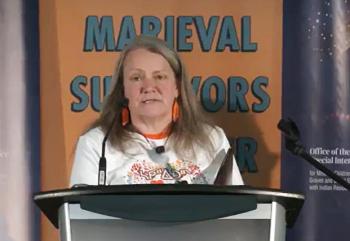Image Caption
Summary
Local Journalism Initiative Reporter
Windspeaker.com
An interim report from the office of the independent special interlocutor into missing children, unmarked graves and burial sites associated with Indian residential schools was released at Cowessess First Nation in Saskatchewan June 16.
Interlocutor Kimberly Murray reports in Sacred Responsibility: Searching for the Missing Children and Unmarked Burials that a multitude of barriers still exist in undertaking the work.
“Why is it that we’re still at a state in this country that survivors have to fight for people to listen and appreciate and understand that when we say ‘there’s burials on these grounds’ (that) there’s burials on these grounds?” said Murray, a member of the Kahnesatake Mohawk Nation. She was appointed in June 2022 by federal Justice Minister David Lametti.
Her appointment came a year after the results of ground-penetrating radar searches were announced by Tk'emlúps te Secwe̓pemc in British Columbia and Cowessess First Nation. Searches undertaken at Indian residential school sites in their communities indicated 215 unmarked burial sites at the former Kamloops Indian Residential School and 751 unmarked burial sites at Marieval Indian Residential School, respectively.
Murray’s mandate includes providing recommendations for a new Indigenous-led legal framework to protect unmarked burial sites and support the recovery of the missing children.
“We’re now saying (this) is a reparations framework,” said Murray, former executive director of the Truth and Reconciliation Commission (TRC).
In her 178-page interim report, Murray writes that a new legal framework must be seen through the lens of reparations.
“Reparations must involve truth-finding, because unless truth is revealed, families will continue to suffer and public denialism can flourish. Without legislative and institutional reform, apologies and promises that similar violations will not be repeated ring hollow to victims,” she states in the report.
The report outlines 48 recommendations, many of which were directed at the federal government. They include the need for “clear legal mechanisms” to hold individual perpetrators and institutions accountable for harms committed against children who went missing and residential school survivors.
She also calls for the inclusion of and respect for Indigenous laws, protocols and processes throughout investigations into the deaths of the children.
The government is also called to support access to and protection of the sites; to protect buildings or sites as heritage designations; to address denialism of the truth of Indian residential schools, including the implementation of both civil and criminal sanctions; and to repatriate cemetery and unmarked burial sites in a more timely manner.
The federal government was also called upon to provide sufficient, long-term funding to do the necessary work and to support the health and wellness of survivors, families and communities.
Lametti, who attended the announcement virtually from Ottawa, said he had “begun to invest” in Calls to Action 42 and 50 from the TRC on the legacy of Indian residential schools.
Call 42, in part, directs the federal, provincial, and territorial governments to recognize and implement Indigenous justice systems, while Call 50, in part, directs the federal government to work with Aboriginal organizations and fund the establishment of Indigenous law institutes.
Lametti said the two Calls to Action would help “promote the reflourishing of Indigenous legal systems. I know that’s something the special interlocutor has noted is going to be crucial moving forward, the use of Indigenous law. And I believe that.”
Lametti said he was uncertain as to why, eight years after the TRC had delivered its final report, the federal Liberal government continued to be slow in implementing the Calls to Actions.
At the time they were delivered, Prime Minister Justin Trudeau committed to implementing them all.
“I push as hard as I can in the areas that fall under my jurisdiction as minister of Justice and I try to push my colleagues,” said Lametti.
Recommendations in the interim report also address the need to make access to records from all parties easier and for records to not be destroyed.
“Today, survivors continue to fight for records,” said Murray.
The report outlines the continued difficulty in getting records from churches, governments, archives, international sites, and even the National Centre for Truth and Reconciliation (NCTR), which was established as part of the Indian Residential Schools Settlement Agreement.
While Murray acknowledged the “important work” the NCTR was doing, she said that at the multiple gatherings she has hosted in Indigenous communities across the country, survivors have continued to voice their concerns about accessing records at the NCTR, housed at the University of Manitoba. University protocols on top of multiple legislations make access to records difficult.
“Therefore, there is an urgent need to amend or create new legislation, regulations and policies related to the National Centre for Truth and Reconciliation so that survivors, their families and communities can have sovereignty over the information it holds,” she said.
Murray is now halfway through her mandate and is adamant that she will meet the goal of making recommendations for a new legal framework by the end.
“I think what we really need to think about is how will we ensure that the recommendations that are coming from survivors and communities, how will they be implemented, and what will the oversight of those recommendations and implementation be?” she said.
Murray pointed out that establishment of a National Council for Reconciliation, one of the 94 Calls to Action issued by the TRC, had yet to be implemented.
The national council is meant to be the oversight body to ensure Canada, the provinces and the churches are held accountable and are implementing the Calls Action.
“We don’t have that national council yet. Here we are eight, nine years later. And so how can we ensure that the final report of my office doesn’t get put on the shelf?” said Murray.
Local Journalism Initiative Reporters are supported by a financial contribution made by the Government of Canada.

